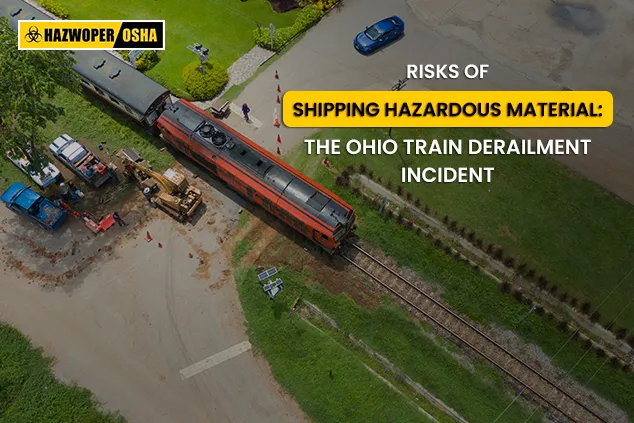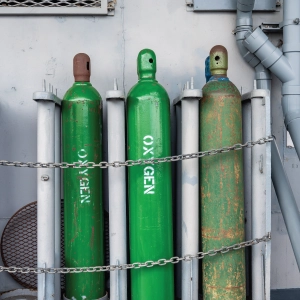Risks of Shipping Hazardous Material: The OHIO Train Derailment Incident

Introduction:
Hazardous materials are integral to various industries, including chemical, agriculture, healthcare, and manufacturing, making their use unavoidable due to their critical roles in production and operations.
Shipping hazardous materials poses significant risks, both to human health and the environment. These materials, which include chemicals, flammable substances, and radioactive elements, can cause severe accidents if not handled properly. Potential dangers include spills, fires, explosions, and contamination, all of which can lead to injuries, fatalities, and long-term environmental damage.
Therefore, transporting these materials is a complex process that necessitates stringent adherence to specific rules and regulations tailored to each mode of transport, whether by road, rail, sea, or air.
The Ohio train derailment incident is a tragic reminder of the importance of safely transporting hazardous materials through rail. Therefore, in this article, we will dig deeper into the actual incident, understand the regulations pertaining to shipping hazardous materials and explore safety measures that need to be implemented in case of accidents.
What happened in the Ohio Train Derailment Incident?
On Feb 3, 2023, in East Palestine, Ohio, a North folk Southern freight train derailed. As a result, vinyl chloride, which is a hazardous & carcinogenic substance, was released. Following the crash, around 1500 residents were informed to evacuate. The officials decided to pour out and burn five tank cars due to the fear of explosion.
EPA and other agencies made a joint effort to counter the incident. However, despite the officials' assurance that the air and water quality were good, residents detailed many health issues, such as burning eyes, rashes, and nausea. A program manager at the Environmental Protection Agency (EPA) ordered an EPA contractor to fabricate the records regarding vinyl chloride detection. EPA used a plane to detect the presence of airborne chemicals. The program manager instructed the plane operators to turn off the sensors while flying over the site. The plane carried out two flights, which recorded the data for only eight minutes, which is less than the regular protocol.
People started questioning the EPA about their testing procedures, as some experts suggested that they were not detailed enough to detect all the likely byproducts from burning toxic substances. After this incident, people started doubting rail safety and transportation regulations for hazardous materials. This led to residents filing lawsuits against Norfolk Southern for causing the incident.
EPA and U.S. Justice Department's Legal Action to Ohio Train Derailment:
An EPA whistleblower, Robert Kroutil, was the one who pointed out the discrepancies of EPA related to the investigation. He mentioned that the EPA did not perform normal procedures when testing for chemical contamination after the train derailed. He questioned the late deployment of the plane and demanded EPA to release more information regarding the investigation they had done. He decided to file his own FOIA request to dig deeper into the ASPECT plan flight's actual mission.
The U.S. EPA, the U.S. Department of Justice, and the local authorities were the primary agencies involved in the cleanup efforts and response. The EPA and the U.S. Justice Department filed charges against Norfolk Southern to get the railroad to cover all cleanup costs. These penalties hold Norfolk Southern responsible for the damages and health issues due to the derailment incident.
The U.S. railroad operator Norfolk Southern (NSC.N) has befitted to pay $600 million to settle the lawsuit against it.
Norfolk Southern will pay a $15 million civil penalty. It will also compensate EPA for its expenses, which totaled almost $57 million as of November 30, 2023.
NSC.N has also agreed to clean up the incident site and implement several environmental remediation projects to deal with the prior pollution.
Apart from this, they will also set up a $25 million community health program to offer mental health services and medical exams for the first responders and the community for the next 20 years. Thus, spending almost $244 million on the safety initiatives through 2025.
EPA faced the following implications in the aftermath of the derailment incident:
- EPA was made to direct and oversee the cleanup activities and remove the contaminated soil and water.
- As a part of a settlement agreement with Norfolk Southern, EPA provided access to health monitoring and mental health services.
Implementing OSHA and EPA Guidelines in Hazmat Transportation:
OSHA's guidelines encompass all the topics pertaining to the transportation of hazardous materials, including their labelling and storage, training employees and emergency response procedures. By adhering to these guidelines, one can reduce the probability of exposure, spill risk, and other incidents that threaten the safety and health of the workers involved in shipping procedures. OSHA severely penalizes those who don't comply with its regulations, along with the increased chance of accidents with devastating consequences.
EPA has a set of standards for emergency response procedures that establish the use of appropriate measures in one place and reduce the impact of incidents regarding hazardous materials. Compliance with EPA guidelines is necessary to avoid fines and legal penalties and to meet the ethical responsibility of protecting the environment.
What could have been done to avoid such incidents?
This incident sheds light on the need for in-depth testing protocols to detect all possible contaminants, transparent risk communication, dealing with community concerns, and extending evacuation until safety is confirmed by stringent testing. The investigative authorities should have:
- The authorities could have utilized advanced analytical methods to test the environment before announcing the area to be safe and clean.
- EPA should have done the investigation properly, offering daily updates, and showing the result to the public.
- They should have given extended evacuation orders, till comprehensive testing was done over a longer period, to cancel out all the health risks.
- Lastly, authorities should have reviewed the protocols, industry practices, and emergency responses in detail while investigating.
Possible risks associated with Hazardous Material Transportation Through Rail
Among all the other modes, rail is the safest for transporting large quantities of hazardous materials over long distances. There are still risks that need strict safety measures. Key risks with hazmat transportation through rail include:
- Derailments and collisions.
- Tank car integrity issues.
- Risks of explosions.
- Environmental contamination through spills and leaks.
Railroads collaborate with regulatory agencies to analyze and decide the safest routes for shipping hazardous materials. It also considers factors like risk assessment and population density. Security measures are also implemented to stop intentional acts of terrorism and sabotage.
We are helping Through Our Course
Without adhering to protocols for hazardous material transportation, accidents are always on the brink. That's why HAZWOPER OSHA, Training L.L.C. has designed a detailed training course on D.O.T. Hazmat Carrier Requirements: Rail course. We have a solid record of providing updated, quality training in your preferred learning format as well. That's why we have a loyal client base in every industry.
Conclusion:
In this modern era, the transportation of hazardous materials is essential in contemporary society, but it has deep-rooted risks that require strict adherence to safety protocols and guidelines. Non-compliance consequences include life losses, costly accidents, and severe environmental damage. The only way to safely ship hazardous materials is by sticking to OSHA and E.P.A. regulations and detailed employee training programs. These steps ensure mitigation of risks while ensuring workers' well-being. As an industry leader, we advise all stakeholders to prioritize safety and choose our comprehensive hazardous material training programs.
References:
U.S. Department of Transportation, March 8, 2023, Hazardous Material Transportation, https://railroads.dot.gov/research-development/program-areas/hazmat-transportation/hazardous-materials-transportation
Department of Environment Protection, East Palestine Train Derailment: What DEP is doing?, https://www.dep.pa.gov/About/Regional/SouthwestRegion/Community%20Information/Pages/Ohio-Train-Derailment.aspx
Environment Protection Agency, May 24, 2024, East Palestine, Ohio Train Derailment https://www.epa.gov/east-palestine-oh-train-derailment
The New York Times, Feb 2, 2024, Ohio Train Derailment Separating Facts from Fiction,
https://www.nytimes.com/2023/02/28/us/ohio-train-derailment-east-palestine.html
The Guardian, Feb 15th, 2023, what do we know about Ohio train derailment and toxic chemical leaks?
https://www.theguardian.com/world/2023/feb/15/ohio-train-derailment-palestine-toxic-chemical-leak
News Nation, May 14, 2024, EPA ‘failed to protect’ East Palestine residents after Ohio train derailment: Whistleblower, https://www.newsnationnow.com/us-news/midwest/ohio-train-derailment/epa-procedures-derailment-whistleblower/
United States Environmental Protection Agency, May 23, 2024, United States Reaches Over $310 Million Settlement with Norfolk Southern to Address Harms Caused by East Palestine Train Derailment, https://www.epa.gov/newsreleases/united-states-reaches-over-310-million-settlement-norfolk-southern-address-harms

 EN |
EN |  ES
ES






























































































































